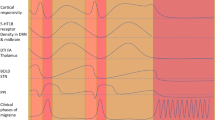Abstract
Purpose of Review
The hippocampus is involved in pain processing, pain-related attention and anxiety, and stress response. The present review compiles the present knowledge of hippocampal volume, activity, and connectivity regarding migraine.
Recent Findings
For hippocampal volume, a longitudinal study discovered decreased volume in newly diagnosed migraine patients after 1 year. Two cross-sectional studies suggested an adaptive increase of volume at low headache frequency and a maladaptive decrease of volume at higher headache frequency. Patients who carried a COMT Val homozygous were found to have larger hippocampi on both sides compared with healthy controls with the same polymorphism. For hippocampal activation, one study showed greater nociceptive activation in patients with migraine compared to healthy controls, with the activity correlated to headache frequency. Another study showed greater deactivation and higher functional connectivity linked to other pain-processing regions in low frequency compared to high-frequency migraineurs. At resting state, intraregional functional connectivity of hippocampus was demonstrated to be lower, and connectivity of the hippocampus with other brain regions was different in patients carrying specific genetic variants. For structural connectivity, two studies suggest a stronger connectivity between the hippocampus and other corticolimbic regions, and the altered connectivities are responsible for migraine-associated allodynia or placebo effect of migraine.
Summary
Factors including headache frequency, accumulative number of migraine attacks, anxiety score, depression score, and genetic variants are related to hippocampal morphology and functional changes in people with migraine. Future studies should select participants precisely and appropriately control for genetic variants to investigate the complex relationship between the hippocampus and migraine.
Similar content being viewed by others
References
Papers of particular interest, published recently, have been highlighted as: • Of importance
Borsook D, Maleki N, Becerra L, McEwen B. Understanding migraine through the lens of maladaptive stress responses: a model disease of allostatic load. Neuron. 2012;73(2):219–34. https://doi.org/10.1016/j.neuron.2012.01.001.
Sauro KM, Becker WJ. The stress and migraine interaction. Headache. 2009;49(9):1378–86. https://doi.org/10.1111/j.1526-4610.2009.01486.x.
Maleki N, Becerra L, Borsook D. Migraine: maladaptive brain responses to stress. Headache. 2012;52(Suppl 2):102–6. https://doi.org/10.1111/j.1526-4610.2012.02241.x.
Liu MG, Chen J. Roles of the hippocampal formation in pain information processing. Neurosci Bull. 2009;25(5):237–66. https://doi.org/10.1007/s12264-009-0905-4.
Lucassen PJ, Pruessner J, Sousa N, Almeida OF, Van Dam AM, Rajkowska G, et al. Neuropathology of stress. Acta Neuropathol. 2014;127(1):109–35. https://doi.org/10.1007/s00401-013-1223-5.
Chong CD, Dumkrieger GM, Schwedt TJ. Structural co-variance patterns in migraine: a cross-sectional study exploring the role of the hippocampus. Headache. 2017;57(10):1522–31. https://doi.org/10.1111/head.13193.
Hubbard CS, Khan SA, Keaser ML, Mathur VA, Goyal M, Seminowicz DA. Altered brain structure and function correlate with disease severity and pain catastrophizing in migraine patients. eNeuro. 2014;1(1):e20.14. https://doi.org/10.1523/ENEURO.0006-14.2014.
• Liu HY, Chou KH, Lee PL, Fuh JL, Niddam DM, Lai KL, et al. Hippocampus and amygdala volume in relation to migraine frequency and prognosis. Cephalalgia. 2016;37(14):1329–36. https://doi.org/10.1177/0333102416678624. The study comprised migraine patients with a whole spectrum of headache frequencies and demonstrated the bidirectional relationship between hippocampal volume and headache frequency.
Liu J, Lan L, Mu J, Zhao L, Yuan K, Zhang Y, et al. Genetic contribution of catechol-O-methyltransferase in hippocampal structural and functional changes of female migraine sufferers. Hum Brain Mapp. 2015;36(5):1782–95. https://doi.org/10.1002/hbm.22737.
• Maleki N, Becerra L, Brawn J, McEwen B, Burstein R, Borsook D. Common hippocampal structural and functional changes in migraine. Brain Struct Funct. 2013;218(4):903–12. The pioneer study that described changes of hippocampal volume, activity, and connectivity in migraine patients with different headache frequencies. https://doi.org/10.1007/s00429-012-0437-y.
Liu J, Lan L, Li G, Yan X, Nan J, Xiong S, et al. Migraine-related gray matter and white matter changes at a 1-year follow-up evaluation. J Pain. 2013;14(12):1703–8. https://doi.org/10.1016/j.jpain.2013.08.013.
Schwedt TJ, Chong CD, Chiang CC, Baxter L, Schlaggar BL, Dodick DW. Enhanced pain-induced activity of pain-processing regions in a case-control study of episodic migraine. Cephalalgia. 2014;34(12):947–58. https://doi.org/10.1177/0333102414526069.
Gao Q, Xu F, Jiang C, Chen Z, Chen H, Liao H, et al. Decreased functional connectivity density in pain-related brain regions of female migraine patients without aura. Brain Res. 2016;1632:73–81. https://doi.org/10.1016/j.brainres.2015.12.007.
Alexander-Bloch A, Giedd JN, Bullmore E. Imaging structural co-variance between human brain regions. Nat Rev Neurosci. 2013;14(5):322–36. https://doi.org/10.1038/nrn3465.
• Liu J, Ma S, Mu J, Chen T, Xu Q, Dun W, et al. Integration of white matter network is associated with interindividual differences in psychologically mediated placebo response in migraine patients. Hum Brain Mapp. 2017;38(10):5250–9. The study demonstrated the white matter network of hippocampus and its relation to the placebo effect in patients with migraine. https://doi.org/10.1002/hbm.23729.
Author information
Authors and Affiliations
Corresponding author
Ethics declarations
Conflict of Interest
Hung-Yu Liu, Kun-Hsien Chou, and Wei-Ta Chen declare no conflict of interest.
Human and Animal Rights and Informed Consent
This article does not contain any studies with human or animal subjects performed by any of the authors.
Additional information
This article is part of the Topical Collection on Chronic Daily Headache
Rights and permissions
About this article
Cite this article
Liu, HY., Chou, KH. & Chen, WT. Migraine and the Hippocampus. Curr Pain Headache Rep 22, 13 (2018). https://doi.org/10.1007/s11916-018-0668-6
Published:
DOI: https://doi.org/10.1007/s11916-018-0668-6




